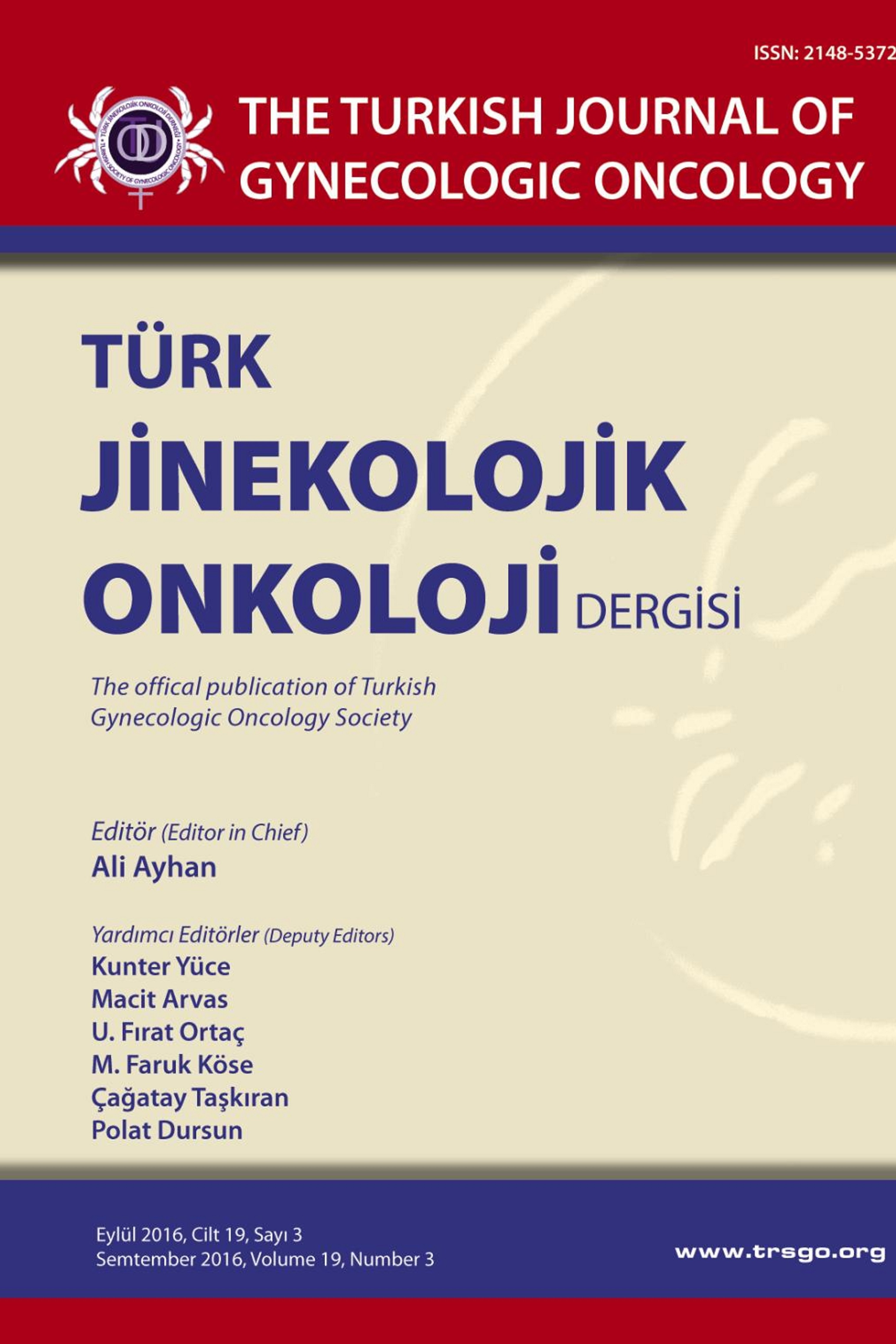SERVİKAL BİOPSİLERDE ENFEKSİYON TANISI
Giriş: Pap test ile saptanan hücresel anormalliklerin bir kısmının enfeksiyona bağlı olduğu bilinmektedir. Ancak bu anormalliklerin derecesine veya gözle görülen lezyonun şiddetine göre değerlendirmek üzere servikal biyopsi alınmaktadır. Kronik enfeksiyonların yaptığı lezyonları preinvaziv servikal değişikliklerin yaptığı lezyonlardan ayırt etmek güçleşmektedir. Bu çalışmada servikal bir smear patolojisi veya şüpheli görünüm nedeniyle biyopsi yapılan olgularda enfeksiyon oranını araştırdık. Yöntem: Servikal biyopsi yapılarak doku tanısı konulan 90 hastanın, biyopsi ve smear test sonuçları karşılaştırıldı. Tanı uyumluluğu ve sonuç değerlendirilmesi yapıldı. Kronik servisit oranları belirlendi. Bulgular: Çalışmaya biyopsi öncesi smear sonucu, 3 High Grade Squamous Intraepithelial Lesion (HSIL), 44 Low Grade Squamous Intraepithelial Lesion (LSIL), 18 Atypical Squamous Cells of Undetermined Significance (ASCUS) olan hasta ile 3 Atypical Squamous Cells- Cannot Exclude HSIL (ASC-H), 2 Atypical Glandular Cells of Undetermined Significance (AGUS), 1 malign sitoloji,1 koilositoz, 3 kuşkulu sitoloji ve 1 reaktif atipili olarak bildirilen hastalar alınmıştır. Ayrıca 14 hastadan, smear olmadan veya sonucu benign olup klinik şüphe üzerine servikal biyopsi alınmıştır. Smearde LSIL olanların 20'si (%46.51), ASCUS olanların 6'sı (%33.3), HSIL olanların 1'inde (%33.3), ASC-H smearlerin 1'inde (%33.3), AGUS smearlerin 1'inde (%50) kronik servisit saptandı. Toplam 34 hastada kronik servisit (%37.77) saptandı. Sonuç: Anormal pap test sonucu veya klinik şüphe üzerine alınan servikal biyopsilerdeki kronik servisit şeklinde raporlanan servikal enfeksiyon, smear sonucunu önemli ölçüde etkilemekte ve gereksiz girişimlere yol açmaktadır. Şüpheli durumlarda biyopsi öncesinde enfeksiyon araştırılarak, varsa tedavisinden sonra smear alınması gereksiz işlemleri azaltabilir.
DIAGNOSIS OF INFECTION IN CERVICAL BIOPSIES
Introduction: It is known that the some of cellular abnormalities which are detected by pap-smear test are due to infections. However cervical biopsy is performed according to stage of these anormalities or severity of lesions observed in pelvic examination. It is difficult to differentiate cervical lesions caused by chronic infections and preinvasive cervical changes. In present study, cervical infection ratio was investigated in cases to whom cervical biopsy was performed due to pap-smear pathology or suspicious cervical lesions in pelvic examination. Methods: Cervical biopsy and pap-smear test results were compared in 90 patients who had tissue diagnosis by method of cervical biopsy. Diagnostic accuracy and results of these two methods were evaluated. Ratio of chronic cervicitis was determined. Results: In present study, 3 patients with High Grade Squamous Intraepithelial Lesion (HSIL), 44 patients with Low Grade Squamous Intraepithelial Lesion (LSIL), 18 patients with Atypical Squamous Cells of Undetermined Significance (ASCUS), 3 patients with Atypical Squamous Cells- Cannot Exclude HSIL (ASC-H), 2 patients with Atypical Glandular Cells of Undetermined Significance (AGUS), 1 patient with malign cytology,1 patient with koilocytosis, 3 patients with suspicious cytology and 1 patient with reactive atypia were included. Besides in 14 patients cervical biopsy was performed because of clinical suspicion without result of cervical pap-smear or having benign pap-smear result. Among LSIL pap smear results 20 (46.51%) patients, among HSIL papsmear results 6 (33.3%) patients,among ASC-H pap-smear results 1 (33.3%) patients and among AGUS pap-smear results 1 (50%) patients had chronic cervicitis. Totally 34 (37.77%) patients had chronic cervicitis. Conclusion: The infection reported as chronic cervicitis in cervical biopsies, which are performed due to abnormal pap-smear test results or clinical suspicion, significantly affect the pap-smear test results ve lead to unnecessary interventions. So occurence of infection should be investigated before cervical biopsy in suspicious cases and if detected, should be treated before biopsy to decrease unnecessary interventions.
